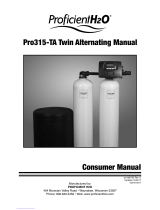
5
2.4 Drain Line Connection
A drain for the regeneration and/or backwashing cycles is required. Locate
the drain within 10m of the water softener. Connect the drain port of the
valve to the drain using a flexible hose of adequate sizing. This hose will be
under pressure when the regeneration/backwash cycle is working; therefore
make sure the drain line is secured.
Allow an air gap between the drain tubing and waste line to prevent the
possibility of reverse siphoning and/or bacteria spreading up from the drain
into the drain line and subsequently into the delivery.
2.5 Brine Tank Refill
The system is designed so as to allow for refilling half the amount of brine
drawn. For example, if 500 litres of brine is drawn, the softener will
automatically refill about 250 litres. A hosepipe or bucket should therefore
be provided to fill up the brine tank.
The control valve is controlled by a timer that is set to count the operating
cycles. Once the set regeneration time is reached, the system will regenerate
automatically, preferably at night at 1am to 3am.
If power is disconnected, the system could regenerate at a time when soft
water is required. Therefore, always regenerate manually if water
consumption is not continuous. The system allows a bypass when
regenerating, so hard water is passed into supply during this period.
3.1 Service
Hard water flows through the cation exchange resin in a downward direction
and is softened. The cation exchange process continues for a particular
length of time set to allow the resin to be exhausted. At this point, the resin
must be regenerated; a process that occurs automatically. The standard
service flow rate is contained in the equipment specification table on page
3. This cycle is most efficient when the flowrate is 16 bed volumes of resin per
hour.
3. OPERATION
5. Slowly open the inlet and outlet valves and let the unit fill up with water.
This will take a few minutes. Once the sound of running water has
stopped and the softener is full, close the bypass valve.
6. Add appropriate number of salt to the brine tank, and carefully add water
as per equipment specification table. Ensure that the brine level in the
brine well is always below the salt level!

















